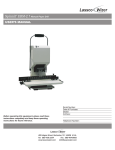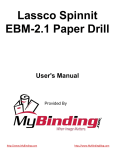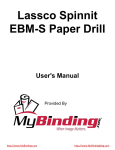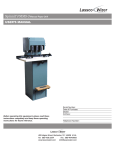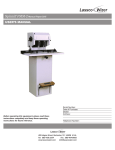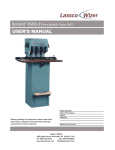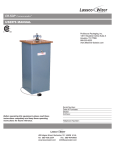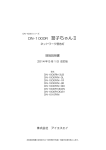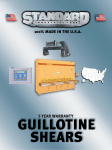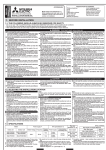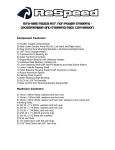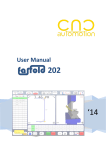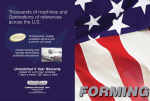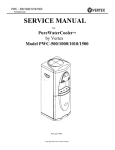Download lassco wizer spinnit ebm-2.1
Transcript
Spinnit EBM -2.1 Manual Paper Drill R USER’S MANUAL Before operating this equipment, please read these instructions completely and keep these operating instructions for future reference. Serial Number: Date of Purchase: Dealer: Address: Telephone Number: 485 Hague Street, Rochester, NY 14606 U.S.A. Tel: 585-436-1934 Fax: 585-464-8665 www.lasscowizer.com [email protected] Table Of Contents 1 - Introduction 1.1 1.2 Your New EBM-2.1 Paper Drill............. Page 01 Shipping Damage Inspection............... Page 01 2 - Safety 2.1 2.2 2.3 Safety Instructions................................ Page 02 Warning Labels..................................... Page 03 Grounding Instructions......................... Page 04 3 - Setting Up Your Machine 3.1 3.2 3.3 3.4 3.5 3.6 3.7 3.8 Loose Items Inventory.......................... Page 05 Accessories Warning............................ Page 05 Installing the Table Assembly............... Page 06 Assembly and Installation of the Back-gauge.......................................... Page 07 Installing the Paper Side Stops............ Page 07 Installing the Chip Bag......................... Page 08 Choosing and Installing the Pattern Bar........................................................ Page 08 Electrical Instructions........................... Page 08 4 - Operation 4.1 4.2 4.3 4.4 4.5 4.6 4.7 Protective Guard.................................. Page 09 Drill Bit Removal and Installation......... Page 09 Leveling the Drill Bits............................ Page 10 Adjusting the Back-Gauge................... Page 10 Drilling Procedures............................... Page 11 Traversing the Table............................. Page 11 Tips on Drilling...................................... Page 11 1 - Introduction 1.1 - Your New EBM-2.1 Paper Drill Thank you for your purchase of the Spinnit EBM-2.1 Paper Drill. R We ask that you take a moment to fill in the serial number and other information on the front cover of the manual. Please keep this manual as a reference for future use. For parts and service, please contact the Lassco-Wizer Dealer from whom you purchased the machine. If you require assistance in locating a Lassco-Wizer Dealer please contact our customer service department at 585436-1934. Please have the model of your machine and the serial number when you call. If you wish to write to us, send correspondence to: Lassco-Wizer Attn: Customer Service 485 Hague Street Rochester, NY 14606 1.2 - Shipping Damage Inspection Remove the machine from the carton and inspect for any shipping damage. If any damage is present, report the damage to the carrier immediately; failure to do so may void any warranties. 5 - Maintenance 5.1 5.2 Safety.................................................... Page 12 Annual Lubrication................................ Page 12 6 - Trouble Shooting Guide 6.1 Determining the Cause and Correction to Certain Problems.............................. Page 13 7 - Parts Diagrams 7.1 7.2 7.3 Front, Rear, and Side Views................. Page 14 Internal Views....................................... Page 15 Parts List.............................................. Page 16 Page 01 2 - Safety 2.1 - Safety Instructions All operators must read and understand the Users Manual including all safety instructions before using this equipment. Failure to fully understand the safety instructions can result in personal injury. If after reading the manual you are still uncertain about use, please contact the dealer from whom you purchased the machine for assistance. If you need contact information for a Service Technician nearest you please call 585-436-1934. SAFETY OF THIS EQUIPMENT IS THE RESPONSIBILITY OF THE USER(S). Please read and follow all warning labels on your machine. INDUSTRIAL AND IN-PLANT USE ONLY. This equipment is for use in industrial and in-plant areas only and must be operated by trained and qualified personnel. WEAR PROPER APPAREL. Do not wear loose clothing , gloves, neckties, rings, bracelets, or other jewelry which may get caught in moving parts. Non slip footwear is recommended. Wear protective hair covering to contain long hair. Keep hands clear while operating machine. ALWAYS USE SAFETY GLASSES. Also use face or dust mask if drilling operation is dusty. Everyday eyeglasses only have impact resistant lenses, they are NOT safety glasses. KEEP GUARDS IN PLACE and in working order. Always disconnect the power before servicing this machine. Service should only be performed by a QUALIFIED TECHNICIAN. Always turn the machine to off mode and wait for the drills to stop spinning before installing or removing drill bits. Keep hands away from drills when operating. PLEASE NOTE THAT THE DRILL BITS MAY BE HOT AFTER USE. PROCEDE WITH CAUTION WHEN CHANGING THE DRILL BITS. DON’T USE IN DANGEROUS ENVIRONMENT. Don’t use this machine in damp or wet locations, or expose it to rain. Keep work area well lighted. THIS MACHINE IS DESIGNED FOR ONE PERSON OPERATION. Never operate the machine with more than one person. KEEP CHILDREN AWAY. All visitors should be kept a safe distance from the work area. MAKE WORKSHOP KID-PROOF with padlocks or master switches. DON’T FORCE MACHINE. It will do the job better and safer at the rate for which it was designed. USE RIGHT MACHINE. Don’t force tool or attachment to do a job for which it was not designed. MAINTAIN MACHINE WITH CARE. Keep tools sharp and clean for best and safest performance. Follow instructions for lubricating and changing accessories. REMOVE ADJUSTING KEYS AND WRENCHES. Form habit of checking to see that keys and adjusting wrenches are removed from machine before turning it on. KEEP WORK AREA CLEAN. Cluttered areas and benches invite accidents. DISCONNECT MACHINE before servicing; when changing accessories, such as drill bits, drill blocks, and the like. REDUCE THE RISK OF UNINTENTIONAL STARTING. Make sure the power switch is in the off position before plugging in. USE RECOMMENDED ACCESSORIES. Consult the user’s manual for recommended accessories. The use of improper accessories may cause risk of injury to persons. NEVER STAND ON MACHINE. Serious injury could occur if the machine is tipped. DON’T OVERREACH. Keep proper footing and balance at all times. CHECK DAMAGED PARTS. Before further use of the machine, a guard or other part that is damaged should be carefully checked to determine that it will operate properly and perform its intended function--check for alignment of moving parts, binding of moving parts, breakage of parts, mounting, and any other conditions that may affect its operation. A guard or other part that is damaged should be properly repair or replaced. NEVER LEAVE MACHINE RUNNING UNATTENDED. TURN POWER OFF. Don’t leave machine until it comes to a complete stop. Page 02 2 - Safety 2.2 - Warning Labels English WARNING: DO NOT EXPOSE TO RAIN OR USE IN DAMP LOCATIONS. French AVERTISSEMENT: NE PAS EXPOSER À LA PLUIE ET NE PAS UTILISER DANS LES EMPLACEMENTS HUMIDES Page 03 2.3 - Grounding Instructions Diagram 2-10 METAL SCREW GROUNDING PIN COVER OF GROUNDED OUTLET BOX In the event of a malfunction or breakdown, grounding provides a path of least resistance for electric current to reduce the risk of electric shock. This tool is equipped with an electric cord having an equipment-grounding conductor and a grounding plug. The plug must be plugged into a matching outlet that is properly installed and grounded in accordance with all local codes and ordinances. DO NOT MODIFY THE PLUG PROVIDED. If it will not fit the outlet, have the proper outlet installed by a QUALIFIED ELECTRICIAN. Improper connection of the equipment-grounding conductor can result in a risk of electric shock. The conductor with insulation having an outer surface that is green with or without yellow stripes is the equipment-grounding conductor. If repair or replacement of the electric cord or plug is necessary, do not connect the equipment-grounding conductor to a live terminal. Check with a QUALIFIED ELECTRICIAN or service personnel if the grounding instructions are not completely understood, or if in doubt as to whether the tool is properly grounded. Use only 3-wire extension cords that have 3-prong grounding plugs and 3-pole receptacles that accept the machine’s plug. This machine is intended for use on a circuit that has an outlet that looks like the one illustrated in diagram 2-10. The machine has a grounding plug that looks like the plug illustrated in diagram 2-10. Make sure the machine is connected to an outlet having the same configuration as the plug. No adapter is available or should be used with this machine. If the machine must be reconnected for use on a different type of electric circuit, the reconnection should be made by qualified service personnel; and after reconnection, the tool should comply with all local codes and ordinances. Page 04 3 - Setting Up Your Machine 3.1 - Loose Items Inventory Please remove and inspect the following items: EZ-114A: Table Assemlby (1) FM4-4006: Paper Side Stops (2) FM4-4007: Side Stop Screws (4) EZ-115A: Back-gauge (1) EZ-1028: Clamp Bracket (1) and FM7-7005: 1/4” Knob (1) EZ-1014: Table Stop (1) EZ-1016: Pattern Bars (set of 5) Hollow Drill Bit (1) (these items may be installed) SPIN-EZE: Drill Bit Lubricant (1) EBM2-1034: 25” Drill Strip (1) 1/4” Lock Washers (2) HEX-18: Hex Wrench 1/8” (1) 10-32 Elastic Stop Nuts (2) HEX-332: Hex Wrench 3/32” (1) 50-35: 5/16”-18 Elastic Stop Nut (1) EBM2-1048: Chip Bag (1) EBM-32: Chuck Release Key (1) CC-2: Chip Clearer (1) EBM-76: Black Fiber Washer (1) 3.2 - Accessories Warning USE RECOMMENDED ACCESSORIES. Only use accessories approved by a Lassco-Wizer. The use of improper accessories may cause risk of injury to persons. Page 05 3 - Setting Up Your Machine 3.3 - Installing the Table Assembly 3.3.1 Grasping the Table and depressing the Release Handles to unlock the Release Pin, slide the V-Bars located on the underside of the Table into the V-Rollers on the Base of the machine as shown. 3.3.2 Please note that one of the Table Stops (EZ-1014) comes installed. Make sure when installing the Table onto the Base you are sliding it from right to left (while facing the machine) to avoid obstruction from the pre-installed Table Stop. 3.3.3 Please note that, although they are factory set, you may have to adjust the cams on the V-Rollers if the Table is too tight or too loose after installation. If so, remove the Table. With an open-end wrench and holding the screw head in place with a screwdriver, adjust the cam spacers under the V-Rollers. If the Table is too tight, adjust the V-Rollers out towards the edge of the Fork Plate (EZ-1000). If the Table is too loose, adjust the V-Rollers in toward the center of the Fork Plate. Diagram 3-20 Diagram 3-10 Diagram 3-30 V-Bars Release Pin Fork Plate Table Slide Stop V-Rollers Release Handles Cam Spacers Underside of Table 3.3.4 Attach the second Table Stop (EZ-1014) to the underside of the table using two (2) 1/4” lock washers and two (2) 10-32 Elastic Stop Nuts as shown. Tighten with a wrench until secure. Diagram 3-40 1/4” Lock Washers 10-32 Elastic Stop Nuts Page 06 3 - Setting Up Your Machine 3.4 - Assembly and Installation of the Back-gauge 3.4.1 Assemble the Backgauge by placing the Black Fiber Washer (EBM-76) over the Threaded Stud. Place the Clamp Bracket (EZ-1028) on the Threaded Stud with the knob end toward the center of the assembly. Tighten the Elastic Stop Nut on the Threaded Stud with a wrench until it is snug, allowing the Clamp Bracket to move with slight resistance. Diagram 3-50 Threaded Stud Black Fiber Washer Clamp Bracket & 1/4” Knob 5/16”-18 Elastic Stop Nut 3.4.2 Attach the Backguage to the Table by hooking the left end over the Side Iron (FM4-4003) on the side as shown in the accompanying picture. Align both ends of the Backgauge using the Table Scales (3S-14) so that it is squared correctly. When it is positioned as desired tighten down the Clamp Bracket Knob as shown. 3.4.3 Do not position the Backgauge too close to the hollow drill bit so that it touches. This can cause serious damage to the hollow drill bit causing it to break or shatter. The Backgauge must be at least 1/8” from the circumference of the hollow drill bit. Diagram 3-60 Diagram 3-70 3.5 - Installing the Paper Side Stops 3.5.1 Attach the Paper Side Stops (FM4-4006) using two (2) Side Stop Screws (FM4-4007) each. Position the Paper Side Stop as desired and tighten down with light pressure. Diagram 3-80 Page 07 3 - Setting Up Your Machine 3.6 - Installing the Chip Bag 3.6.1 Attach the chip bag as shown by stretching the open end over the top hook of the chip chute. Continue fitting it around the entire edge of the chip chute making sure it is snug. 3.6.2 Be sure to empty the chip bag regularly as needed. Failure to empty the chip bag can result in clogging of the chip chute. Diagram 3-90 3.7 - Choosing and Installing the Pattern Bar 3.7.1 Your EBM-2.1 comes with five pattern bars included: four (4) common patterns and one blank pattern as shown in diagram 3-100. Choose the pattern bar that lines up with your desired pattern. Diagram 3-100 Blank (Customizable) 3 holes 2-3/4” apart center to center 3 holes 3-1/2” apart center to center 2 holes 2-3/4” apart center to center 3 holes 4-1/4” apart center to center (standard three ring binder) 3.7.2 Insert a Pattern Bar by loosening the Pattern Bar Stop (EZ-1022) and inserting the desired pattern into the slot on the Pattern Bar Guide as shown in diagram 3-110. Insert the angled end into the slot as far as it will go so that the slot at the end of the Pattern Bar lines up with the Pattern Bar Stop. When you have the pattern correctly inserted, tighten down the Pattern Bar Stop through the slot on the Pattern Bar locking it in place. Diagram 3-110 3.8 - Electrical Instructions 3.8.1 Your EBM-2.1 comes with an electrical cord containing the plug to fit into a standard grounded 115V outlet. This machine has a full load draw of 11 Amps. Diagram 3-120 Power Cord 3.8.2 Making sure that nothing is interfering with the drill bits, plug the cord set into a grounded 115V outlet. To turn the machine on, press the Rocker Switch on the front of the shroud. Rocker Switch Page 08 4 - Operation 4.1 - Protective Guard 4.1.1 Your EBM-2.1 comes with a protective guard installed. DO NOT operate this machine without the guard in place. 4.1.2 Please note that when you are performing certain operations such as removing and installing drill bits, you will need to move the guard out of the way. Making sure the power to the machine is disconnected or locked-out, push the guard up and hold in place while performing necessary operations or maintenance. The protective guard should not be removed during operation. Diagram 4-10 4.2 - Drill Bit Removal and Installation CAUTION: DRILL BITS MAY BE HOT AFTER USE. ALLOW DRILL BITS TO COOL DOWN BEFORE TOUCHING. BEFORE REMOVING OR INSTALLING THE DRILL BITS, DISCONNECT OR LOCK-OUT THE POWER SUPPLY. Diagram 4-20 4.2.1 We recommend using a piece of card stock on the Table when leveling the drill bit to avoid drilling into the drill strip. This will lengthen the life of your drill bits and keep them sharper. Tab 4.2.2 Remove the hole guard which is attached to the chuck. This is done by grasping the bent end and sliding the guard off. 4.2.3 Using the Chuck Release Key (EBM-32), insert the tapered end facing down into the chuck hole. With a clockwise motion turn the Chuck Release Key 45 degrees. The drill bit will slide out of the chuck. It is recommended that you hold onto the drill bit so that it does not drop out of the chuck damaging the tip. 4.2.4 To install a drill bit, grasp the drill bit, and being careful to keep it straight, press it up into the chuck. 4.2.5 Seat the drill bit by using a stack of scrap paper. Set the scrap on the table. Step on the foot pedal slowly raising the table toward the Drill Bit. Put light pressure on the hollow Drill Bit seating it firmly in place. 4.2.6 4.2.7 Chuck Release Key Remove the scrap paper and turn the machine on to check the concentricity of the bit. If the bit is not concentric, remove it and repeat steps 4.2.2 through 4.2.5 until it is concentric. Chuck Hole Guard Drill Bit Diagram 4-30 Chuck Hole Guard Drill Bit Diagram 4-40 When the drill bit is correctly installed replace the hole guard back onto the chuck to protect debris from clogging the chuck. SCRAP Page 09 4 - Operation 4.3 - Leveling the Drill Bits 4.3.1 We recommend using a piece of card stock on the Table when leveling the drill bits to avoid drilling into the drill strip. This will lengthen the life of your drill bits and keep them sharper. 4.3.2 To level the drill bit to the Table follow steps 4.3.3 through 4.3.5. 4.3.3 Loosen the Leveling Knob on the right hand side of the machine. 4.3.4 Pull down on the Handle to raise the Table until the hollow drill bit is just touching the Drill Strip (EBM2-1034). 4.3.5 Hold the Handle in place and tighten down the Leveling Knob until it hits the Handle Bracket. This will stop the Handle from being pulled down too far. 4.3.6 It is important to always level the drill bit before each use and after sharpening. This will make sure you don’t drill into the Drill Strip--dulling the hollow drill bit. Diagram 4-40 4.4 - Adjusting the Back-gauge 4.4.1 Adjust the Back-gauge so that it is the correct distance from the edge of the product to the center of the hole to be drilled by performing the following: 4.4.2 Loosen the Clamp Knob on the right side of the Back-gauge. 4.4.3 Using the two (2) Scales embedded in the rear corners of the table, align the front edge of the Back-gauge with the desired distance. 4.4.4 Zero (0) on these scales align with the center of the hollow drill bits. 4.4.5 Tighten down the Clamp Knob when the Back-gauge is positioned as desired. Diagram 4-50 Page 10 4 - Operation 4.5 - Drilling Procedures 4.5.1 When you are ready to drill, set the product to be drilled on the table and make sure it is secure using the Paper Side Stops. Turn the machine on and holding the product firmly in place with one hand, pull down on the Handle raising the Table up to meet the drill bit. Using one consistent smooth stroke, put pressure on the Handle so that the Table rises fully allowing the drill bit to drill through the product. It is important you maintain a consistent speed through the entire stack. It is also important you do not go too slow or too fast. If you drill too slow you can burn the paper leaving undesired marks. If you drill too fast, the drill bits will act more like a punch and they will break or plug. Diagram 4-60 4.6 - Traversing the Table 4.6.1 To move the Table to the next desired hole on the pattern bar, press in on either of the Release Handles (EZ-1010) located on both ends of the table. Pressing in the Release Handle releases the Release Pin allowing the table to traverse. Release the Handle and slide the Table until it locks into place in the next desired position. Diagram 4-60 Table Release Handle Release Handle 4.7 - Tips on Drilling 4.7.1 Use a sharp drill bit at all times... Using a drill bit sharpener, sharpen your drill bits regularly. Apply light pressure when sharpening. Too much pressure may cause flaring of the tip. (Once a drill bit has a flared tip, it becomes defective.) 4.7.2 Sharpening Stone... Use to debur the outside cutting edge of the drill bits for better performance. 4.7.3 Lubricate drill bits occasionally... Use Drill-Ease or Spin-Eze. While the drill is running, simply touch the Drill-Ease stick to the drill bit or brush on the Spin-Eze. Drill through scrap to remove any excess. This will allow for a smoother cut. 4.7.4 Drill Strips...When drilling, a drill bit must stop slightly above the drill strip. Replace worn out drill strips regularly to ensure proper drilling. Page 11 5 - Maintenance 5.1 - Safety ALWAYS DISCONNECT THE POWER BEFORE PERFORMING MAINTENANCE ON THIS MACHINE. MAINTENANCE SHOULD ONLY BE PERFORMED BY A QUALIFIED TECHNICIAN. 5.2 - Annual Lubrication 5.2.1 5.2.2 Lubricating your EBM-2.1 should be done at least once every 12 months; however, it may be necessary to lubricate more often depending on use. Whenever the Table starts becoming difficult to lift, it may be time to lubricate. Diagram 5-10 Insert an oil can (not provided) into the hole on the rear panel just below the Chip Chute. This hole provides direct access to the lift pin. Lubricate the lift pin with a light machine oil. Lift Pin Lubrication Access Hole Page 12 6 - Trouble Shooting Guide 6.1 - Determining the Cause and Correction to Certain Problems Problem Drill bit not concentric. Drill bit not drilling. Cause Correction Foreign material in chuck or in drill plug. Inspect and clean. Drill bit is bent. Replace drill bit. Drill bit not seated in chuck properly. Reinsert drill bit correctly. Chuck is not tight to spindle. Tighten set screw. Drill bit plugged. Remove and clear chips. Check for other foreign matter. Drill bit dull. Sharpen drill bit. Note: In extreme conditions, the drill chuck and/or chip chute may be plugged. Remove the drill bit, loosen the chip chute, pull down, and clean. See Operating Instructions Ball bushings in lift system dry or worn. Lubricate or replace. Lift pin damaged. Replace lift pin. Drive motor loose. Tighten. Machine is sitting on eneven surface. Reposition drill to obtain concentricity Drill bits are out of concentricity. Reinstall drill bits to obtain concentricity. Drill bit was not adjusted to card stock/card stock not used. Adjust per Operating Instructions. Operator not allowing full travel of table. Drill per Operating Instructions through full drilling cycle. Table is too tight or too loose when sliding. V-Rollers under table out of adjustment. With an open-end wrench, and holding screw head in place with a screwdriver, adjust cam spacers under the V-Rollers located on the Fork Plate. See Setting Up Your Machine. Table pivots front and back. Table guides are out of adjustment. Loosen the two screws holding the table guides located on the sides of the upright and readjust. Table lift system lifts unevenly or is noisy. Machine vibrates, wobbles, resonates, etc. Drill bit drills into drill strip/drill bits not drilling through bottom sheet of paper. Page 13 7 - Parts Diagrams 7.1 - Front, Rear, and Side Views Page 14 7 - Parts Diagrams 7.2 - Internal Views Page 15 7 - Parts Diagrams 7.3 - Parts List EZ-108A: Handle Assembly FM5-5006: Rocker Switch (On/Off) EZ-117A: Shroud Assembly FMM5-5514: Chuck FM5-5011: Chuck Release Guard Hollow Drill Bit EBM2-0111A: Pressure Foot Assembly 3S-14: Table Scale EZ-1010L: Table Release Handle (Left) EZ-1010R: Table Release Handle (Right) EBM-44A: Channel Guard FM4-4007: Paper Side Stop Knob (Table Height Adjustment Knob) EZ-1034: Table Guide EZ-107A: Pattern Bar Housing Assembly EZ-1022: Pattern Bar Stop EZ-1004: V-Rail EBM2-110A: Chip Chute Assembly EBM2-1047: Chip Bag Bracket FM5-5008: Power Cord FM4-4003: Side Iron EBM2-1034: Drill Strip EZ-1033: Table EZ-1025: Base Wire Harness FM5-5002: 1/4 HP Motor EBM2-1000: Lift Pin EZ-1001: V-Roller EBM2-111A: Housing Assembly EBM2-1019: Pivot Hub EBM2-103A: Pivot Arm Set Assembly EZ-1026: Lift Bars EZ-1023: Lift Pin Housing EZ-1024: Fork EZ-1000: Fork Plate EZ-1003C: Cam Spacer EBM-82: 6 Amp Fuse Page 16

















